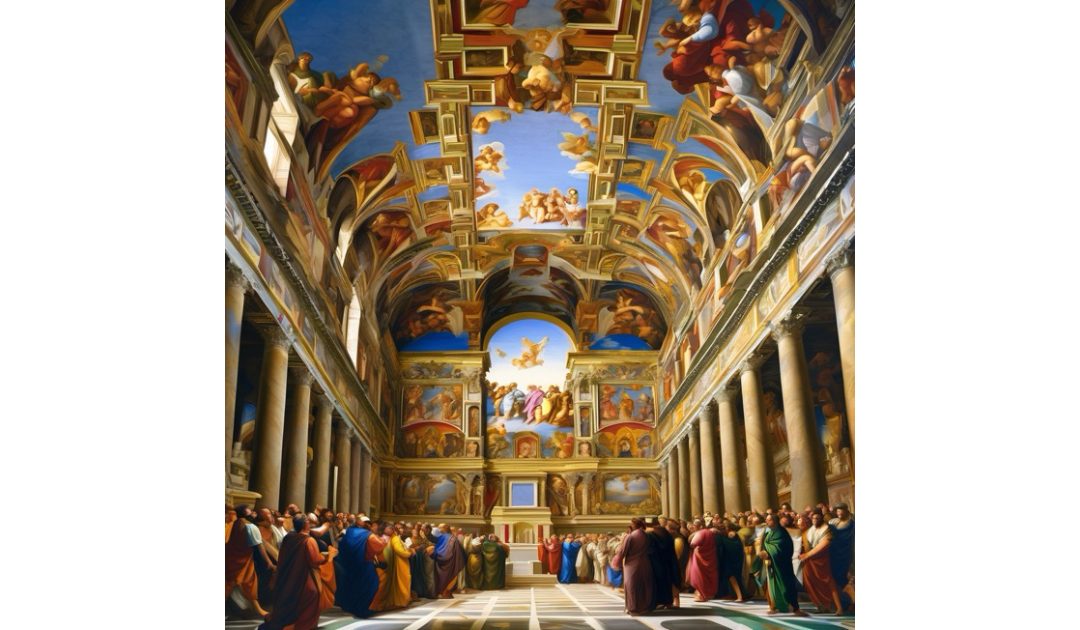On the 1st of November, 1512, the ceiling of the Sistine Chapel, painted by Michelangelo, was exhibited to the public for the first time. Michelangelo di Lodovico Buonarroti Simoni, widely known simply as Michelangelo, is one of the most emblematic figures of the Italian Renaissance, alongside Leonardo da Vinci, amongst others. He was born on the 6th of March, 1475, in Caprese, a small town near Arezzo in Tuscany. He grew up in Florence, a city pulsating with art, culture, and intellectual fervour. His extraordinary talent as a sculptor, painter, architect, and poet left an indelible mark on the Western art tradition.
From a young age, Michelangelo demonstrated an exceptional aptitude for the arts. Despite his father’s initial reluctance, he commenced an apprenticeship at 13 with Domenico Ghirlandaio, a prominent Florentine painter. Here, Michelangelo honed his skills in fresco painting and design. However, his passion gravitated towards sculpture, leading him to study under Bertoldo di Giovanni at the Medici gardens, where he absorbed the classical forms and humanist ideals that would permeate his work.
Michelangelo’s early works already showcased his mastery over the human form. One of his earliest significant sculptures, the “Pietà,” created between 1498 and 1499, depicts the Virgin Mary cradling the dead body of Christ. Housed in St. Peter’s Basilica in Vatican City, the piece astounds with its delicate detailing, emotional depth, and harmonious composition. Michelangelo’s signature delicacy in rendering the folds of fabric and the tranquil sorrow on Mary’s face exemplifies his ability to infuse marble with life.
Perhaps no work embodies Michelangelo’s genius more than “David,” sculpted between 1501 and 1504. This colossal statue, standing over 5 metres tall, portrays the biblical hero with a blend of youthful vigour and contemplative intensity. Unlike earlier depictions of David post-victory, Michelangelo chose to capture him in a moment of tense anticipation, sling over his shoulder, eyes fixed on his impending adversary. The statue’s anatomical precision and symbolic resonance with Florentine independence made it an iconic symbol of the city.
Michelangelo’s reputation as a sculptor led Pope Julius II to commission him for a vastly different project: the frescoes of the Sistine Chapel ceiling, completed between 1508 and 1512. Initially reluctant, Michelangelo viewed himself more as a sculptor than a painter. Nevertheless, he accepted the challenge, producing a monumental masterpiece that redefined the possibilities of fresco art. The ceiling narrates scenes from the Book of Genesis, including the iconic “Creation of Adam,” where God’s outstretched finger nearly touches Adam’s, symbolising the divine spark of life.
The Sistine Chapel ceiling showcases Michelangelo’s deep understanding of human anatomy and his innovative approach to spatial composition. The figures, imbued with dynamic poses and muscular detail, seem to leap off the ceiling, their expressions conveying profound emotion and narrative depth. The work’s grandeur, both in scale and execution, cemented Michelangelo’s status as a towering figure in Renaissance art.
Later in his career, Michelangelo returned to the Sistine Chapel to paint “The Last Judgment” on the altar wall, a project spanning from 1536 to 1541 under Pope Paul III’s commission. This dramatic fresco diverged from the harmonious beauty of his earlier works, presenting a tumultuous vision of the second coming of Christ and the final judgment of souls. The figures twist and contort in expressive agony and ecstasy, reflecting Michelangelo’s evolving style towards Mannerism, characterised by exaggerated forms and complex compositions.
Michelangelo’s talents extended beyond sculpture and painting. As an architect, he played a pivotal role in designing St. Peter’s Basilica in the Vatican. Appointed chief architect in 1546, he re-envisioned the structure’s design, most notably its magnificent dome, which remains an iconic feature of Rome’s skyline. His architectural philosophy emphasised structural clarity and monumental scale, influencing subsequent generations of architects.
Despite his public acclaim, Michelangelo led a somewhat solitary and introspective life. His extensive correspondence and poetry reveal a man deeply reflective about art, spirituality, and human existence. His sonnets and madrigals, often addressed to close friends such as Tommaso dei Cavalieri, showcase his literary prowess and provide insight into his emotional landscape. Michelangelo’s poetry reflects themes of beauty, divine inspiration, and the artist’s perennial struggle with his craft.
Michelangelo’s influence extended well beyond his lifetime. His works inspired contemporaries and future artists alike, contributing to the development of Mannerism and setting a benchmark for artistic excellence. His approach to human anatomy, emotive expression, and monumental scale became foundational elements in Western art education and practice.
He passed away in Rome on the 18th of February 1564. His remains were returned to Florence and interred in the Basilica of Santa Croce, where a grand tomb honours his memory.

